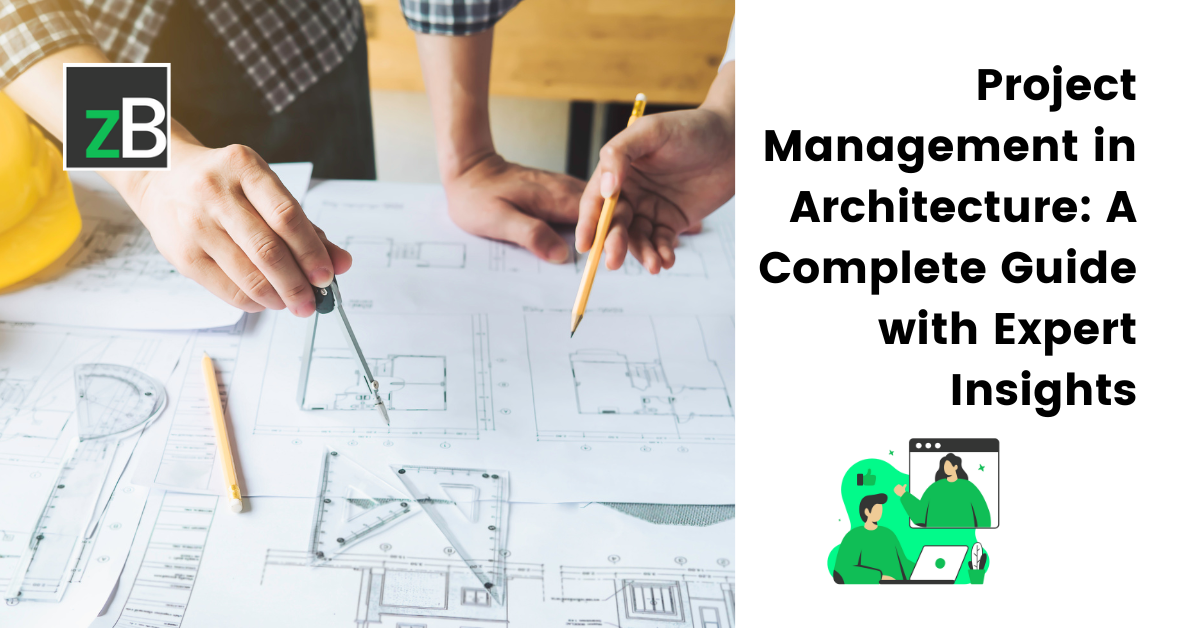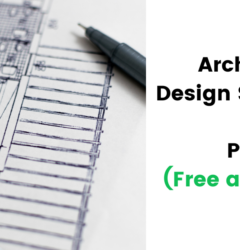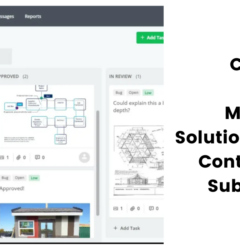Project Management in Architecture: A Complete Guide with Expert Insights
08 Apr

Table of Contents
ToggleWhat are some best practices and tools for project management in architecture? How do you streamline client collaboration and document management? Projects of all sizes have their complexities and challenges, how do you deal with them?
How do you manage projects effectively to ensure they meet schedules and expectations? Covid is long gone, but how did it impact your firm? What are some lessons you picked that are still relevant in this era?
You’ll be reading about answers to these questions and more in this article!
Skip to your favorite sections (using the table of contents at the beginning).
Before we dive in:
This guide on Project Management in Architecture was written based on the transcript of the roundtable discussion on Architectural Project & Document Management hosted by Bhavya Aggarwal, CEO & Founder of zipBoard. The panelists from Plunkett Raysich Architects (PRA) include: Michael Bahr, AIA; Doug Kunde, AIA; Ryan; Schmitz, AIA, NCARB; and Justine Sieber, AIA, NCARB.
Watch the video or continue reading:
What is the Unspoken Rule of Project Management in Architecture?
The unspoken rule of project management in architecture is the necessity to balance the creative and practical aspects of the profession. While architects often enter the field driven by a passion for design, they, over the years, learn that managing projects is an integral part of their role.
This includes not only overseeing the construction process but also managing client expectations, coordinating with various stakeholders, and navigating the complexities of scheduling and resource allocation.
This sentiment was echoed in the roundtable discussion, where Bhavya Aggarwal, CEO & Founder of zipBoard, highlighted how product management, in her case, is similar to project management for architects. “I am a product person and to me, the love of the product comes first and management is not what I look forward to,” she confessed, “but then I do tend to spend a lot more time managing rather than doing the core product work.”
In shedding light on this unspoken rule of architectural project management, Mike Bahr, AIA, Partner and Director of Client Relations at PRA, drawing from his 30 years of experience, emphasized the evolving nature of project management within architectural firms. “In a small firm, there might be less need for formal project management,” he noted, attributing it to the hands-on approach characteristic of smaller teams. However, as firms grow and projects expand in scale, the necessity for structured management becomes apparent.
According to Mike, there are always going to be some skill sets needed for project management regardless of size. This set of skills has to do with client management or people management. It’s needed to set and manage expectations of what the client thinks is going to happen versus what really happens during a project.
In addition, Doug Kunde, AIA, Project Manager and Associate at PRA, echoed Mike’s sentiments, reflecting on his transition from architectural design to project management. “Some days would go by and I didn’t have anything tangible that I produced. I struggled with that concept because all I did all day was plan and strategize,” Doug admitted, highlighting the shift in focus from figuring out how buildings work toward planning and strategizing.
He delved into the complexities of juggling deadlines, resource allocation, and project progress, signifying the pivotal role of foresight and coordination in project management.
Consequently, it’s worth emphasizing that beyond the technical aspects of design and construction, project management in architecture encompasses client relations, resource management, and strategic planning. Hence, as architects navigate the intricacies of their roles, striking a balance between creativity and management remains paramount in achieving success.
How Do You Become A Project Manager in Architecture? Is there any Training?
Now that we’ve spoken about the unspoken rule in architecture, let’s discuss how architects break into project management.
Considering architects typically have their education in architecture, taking on project management responsibilities will necessitate additional training and education. There are numerous methods and avenues through which professionals can upskill – and acquire the necessary skills for effective project management.
According to Mike Bahr, they cultivate a culture of mentorship and knowledge sharing at PRA. “We had a formal mentoring group,” Mike explained, “where seasoned professionals imparted their expertise to younger staff members.” This structured initiative comprised regular engagements and formal sessions aimed at disseminating valuable insights on project management strategies honed through years of experience.
Doug further emphasized the importance of continuous learning, recounting his experience undertaking a project manager training course. This intensive three-day program immersed participants in project management, facilitating interactions with professionals from diverse industries. Doug highlighted the significance of understanding the broader principles of project management, transcending the technical nuances specific to architecture.
It’s worth noting that there’s a fundamental shift in perspective regarding the role of project managers within architectural firms. While a comprehensive understanding of architectural principles remains crucial, the emphasis lies on cultivating a mindset conducive to effective delegation and collaboration.
So what’s the bottom line? There’s no one pathway to becoming proficient in project management in architecture. For architects, gaining project management skills encompasses formal training, mentorship, and experiential learning.
Recommended Reading
https://zipboard.co/blog/aec/how-to-be-a-better-architectural-project-manager/
How to Navigate Complexity: Lessons from Challenging Architectural Projects
The nature of the challenges project architects encounter is multifaceted – ranging from technical constraints to interpersonal dynamics. However, amidst these challenges lie invaluable opportunities for learning and growth. And learning how to navigate these situations is key to ensuring project success, happy clients, and a thriving career.
Mike Bahr recounted a project that epitomized his passion for environmentally responsible buildings. Despite meticulous planning and collaboration, the project encountered a significant setback due to the limitations of the facility management team. Mike candidly acknowledged the pivotal role of effective communication and understanding in overcoming such challenges, emphasizing the importance of aligning stakeholders’ expectations with project goals from the outset.
Subsequently, Justine Sieber, AIA, NCARB, Project Architect and Associate at PRA, underscored the inherent complexity of client relations in architectural projects.
She recounted a complex project involving multiple clients with divergent objectives, necessitating adept mediation and negotiation to ensure alignment and satisfaction among stakeholders. The project’s execution amid the backdrop of the COVID-19 pandemic further compounded the challenges, requiring resilience and adaptability from the project team.
The discussions revealed the importance of proactive communication, stakeholder engagement, and adaptability in mitigating challenges and driving successful project outcomes.
Related Article
https://zipboard.co/blog/aec/how-to-ensure-effective-collaboration-in-construction-document-reviews/
The Impact of Covid on Architectural Project Management
The COVID-19 pandemic reshaped architectural project management, prompting firms to adapt and innovate in the face of unprecedented challenges. While the pandemic is long gone, its impact still lingers to date. Despite its challenges, it opened doors of opportunities to streamline processes, enhance accessibility, cut down time, and increase operational efficiency.
Additionally, Doug shared his experience managing a large project amid the onset of the pandemic, emphasizing the emergence of new skills in navigating virtual meetings and interpreting non-verbal cues. He also added that personal accountability and engagement became paramount, as project managers grappled with the intricacies of fostering collaboration and alignment in virtual settings.
Thus, despite the initial challenges, there are silver linings of remote collaboration in architecture.
Moreover, the pandemic also led to the normalization of virtual interactions as a boon for firms operating on a national scale, according to Mike Bahr. It accelerated the adoption of digital tools and virtual communication platforms, transforming traditional workflows and enhancing collaboration among project stakeholders.
In essence, the pandemic catalyzed a paradigm shift in architectural project management, paving the way for innovation, resilience, and adaptability in the face of adversity. The lessons learned from the pandemic serve as guiding principles that drive progress and innovation in the pursuit of excellence.
Recommended Reading
https://zipboard.co/blog/aec/remote-collaboration-in-architecture-can-architects-work-from-home/
Essential Traits for Success in Architecture
Mike Bahr’s approach diverges from conventional skill-based breakdowns, instead opting for what he terms “skill buckets.” These encompass pivotal aspects such as client interaction, process management, team leadership, and the interconnected domains of finance and marketing. According to Mike, proficiency in each of these areas is indispensable for architects aiming to thrive in their careers.
Central to Mike’s discourse is the significance of interpersonal skills and authenticity. He underscores the importance of genuine engagement and honesty in interactions, whether with team members or clients. From setting clear expectations to addressing challenges head-on, Mike advocates for transparent communication as a cornerstone of effective leadership in architecture.
In addition, Bhavya emphasized the pivotal role of building trust, as it, forms the bedrock upon which successful professional relationships are built. This helps foster collaboration and productivity within teams and with clients alike.
Therefore, success in architecture is diverse and extends beyond technical prowess to encompass qualities of integrity, authenticity, and effective communication. By embodying these essential traits, architects can navigate the complexities of the profession with confidence and purpose, ultimately forging rewarding careers in the field.
Project Management Methodologies, Philosophies, and Tools
Not everyone likes to follow every trend – including firms! Unlike adhering to specific trends or methodologies like Agile, Integrated Project Management, and Critical Chain Project Management (CCPM), Plunkett Rayisch Architects prioritizes pragmatic and effective project management principles.
These principles are tailored to their unique needs and phases of the architectural process – with additional divisions for construction administration and integrated interiors. Mike Bahr mentioned that as their firm evolves and introduces new services, they adapt their project work breakdown structure accordingly, ensuring flexibility and relevance.
Central to their process is a bi-weekly estimation exercise involving all staff, where project commitments and resource allocations are projected. This practice facilitates real-time project tracking and triggers various operational activities such as financial reporting and client engagement.
Importantly, the firm’s leadership convenes regularly to review and reconcile project forecasts, addressing discrepancies and ensuring alignment between individual estimates and project requirements. This collaborative approach fosters transparency and accountability, enabling proactive problem-solving and resource optimization.
Mike emphasized their deliberate avoidance of detailed sub-phase or task-level management, favoring a focus on high-level project oversight. He added that while recognizing the importance of tools like Gantt charts and critical path analysis, the firm prioritizes practicality and client-centric value delivery over complex methodologies.
Ultimately, the guiding principle at Plunkett Rayisch Architects is value creation for clients. By streamlining internal processes and minimizing administrative overhead, the firm ensures that its efforts remain squarely focused on delivering tangible benefits to its clients.
Recommended Reading
https://zipboard.co/blog/aec/architectural-project-management-strategies/
How to Ensure Efficient Document Management in Architectural Projects
According to Ryan Schmitz, AIA, NCARB, Project Manager and Associate at PRA, there’s been a transformative shift from traditional paper-based methods to digital platforms. He emphasized the necessity of leveraging technology to streamline collaboration and overcome logistical challenges inherent in paper-based workflows.
Ryan underscored the importance of digital collaboration tools in facilitating seamless communication and information exchange among internal and external project stakeholders. By utilizing platforms such as Outlook and project management software, the team ensures efficient coordination and progress tracking throughout the project lifecycle.
In addition, Justine emphasized the pivotal role of technology in enhancing communication and organizational efficiency. She highlighted the significance of streamlining processes to ensure that all stakeholders receive timely and relevant information, thereby mitigating potential delays and misunderstandings.
Moreso, Mike elaborated on the firm’s automated project start up process, which leverages technology to streamline administrative tasks and establish standardized workflows. By automating directory creation and team member assignments, the firm ensures consistency and efficiency in document management from project initiation.
This emphasizes the necessity of understanding these aspects thoroughly to mitigate risks and ensure project success.
Bhavya concurred, emphasizing the critical role of technology in modernizing document management practices and fostering collaboration across project teams. She highlighted the importance of adopting digital platforms like Microsoft Teams for efficient communication and information sharing, particularly in multi-stakeholder environments.
Download the Free Resource
Looking into the Future: Anticipating the Future of Architecture
There’s a collective anticipation within the architectural community for a future characterized by enhanced collaboration, technological innovation, and adaptive practices that prioritize value creation for clients.
As the industry continues to evolve, architects like those at Plunkett Rayisch Architects remain committed to embracing change and driving positive transformation in the built environment.
In Doug’s opinion, it’s incredible witnessing the evolution of mentorship and knowledge-sharing among “coworker generations”. He highlighted the transformative impact of technological advancements like Building Information Modeling (BIM) on architectural workflows, enabling more efficient and collaborative design processes.
For Ryan, the expanding possibilities in architectural design facilitated by advancements in materials, systems, and technology are exciting! He underscored the importance of staying abreast of trends and innovating to meet evolving client expectations while also considering the changing dynamics of the workforce.
Justine highlighted the symbiotic learning dynamic between seasoned professionals and younger staff. She emphasized the need for continuous adaptation and skill development to remain agile and relevant in a rapidly evolving industry.
Having the last word, Mike, drew from his extensive experience with technology. He envisioned a future where project management becomes more integrated with 3D modeling and mobile platforms, enabling real-time collaboration and enhancing value delivery to clients. He predicted a shift in the traditional contractual frameworks toward embracing digital models as primary instruments of service.
To support that, Bhavya acknowledged the challenges associated with transitioning from traditional document-centric workflows to more collaborative and digital-centric processes, highlighting the need for broader industry-wide shifts in contractual practices and project delivery methods.
AI's Impact on Architecture: A Tool for Enhancement, Not Replacement
According to Mike, AI serves as a valuable tool but should not supplant the essential human element in architectural practice. While AI can streamline certain tasks and processes, the unique value architects bring—derived from experience, creativity, and critical thinking—remains irreplaceable. He envisioned a future where AI functions as a design assistant, helping architects iterate and optimize solutions without diminishing their creative input.
Doug also echoed this sentiment, likening AI to previous technological advancements like computers, which were initially met with skepticism but ultimately became indispensable tools for productivity and innovation. He emphasized the need for adaptability and a willingness to embrace AI as a means of enhancing architectural practice.
Subsequently, Ryan highlighted the potential of AI to augment human capabilities, enabling architects to focus more on the creative and human-centric aspects of their work. He expressed optimism about the future of AI in design and echoed the industry’s curiosity and excitement about its evolving role.
Overall, the submissions reflected a forward-thinking approach to AI integration in architecture—one that acknowledges its potential while safeguarding the core principles of human-centric design and expertise. As the industry continues to evolve, architects like those at Plunkett Rayisch Architects remain committed to leveraging AI as a tool for advancement and innovation, rather than a replacement for human ingenuity.
Best Practices for Streamlining Client Collaboration
Effective communication lies at the heart of successful client and stakeholder collaboration in architecture.
According to Mike Bahr, it’s important to understand the project’s setup and establish clear expectations from the outset. For projects following a hard-bid approach, he recommended holding partnering meetings to align expectations and define success criteria for all parties involved. This proactive approach helps mitigate potential conflicts and sets the stage for a collaborative working relationship.
Additionally, Doug Kunde echoed the significance of communication, emphasizing the human aspect of architects’ value in facilitating dialogue between clients and contractors. By engaging in one-on-one conversations with each party, architects can gain insights into their perspectives, values, and understanding, ultimately paving the way for finding common ground and aligning objectives.
In a nutshell, by fostering open and transparent dialogue, architects can bridge the gap between stakeholders, build mutual respect, and navigate challenges with greater agility and cohesion.
Where Does zipBoard Come In? How Do We Help?
zipBoard seeks to make collaboration easier in the digital world. It currently solves some of the challenges faced in architectural project management – specifically for streamlining document management and collaboration between all project parties (architects, engineers, contractors, clients, and owners). zipBoard seeks to ensure that your day-to-day as an architect is not spent just coordinating between people.
Watch the video below to see how we’re enabling architecture firms to increase operational efficiency by 80% and save 2 hours per employee per day ⬇️
[Free Brochure]
Document Management Software Developed with Your Architecture Projects in Mind
Get the Brochure and see how zipBoard can help streamline your document management & collaboration.
Read NowAuthor’s bio:
Dorcas Kpabitey is a Content Marketing Specialist at zipBoard. She began her content marketing journey alongside her BA in Political Science and Spanish at the University of Ghana. If she is not tapping away at her keyboard or spending time on Twitter and LinkedIn, she spends her day reading articles, newsletters and books.
Recent Posts
- Why Your Team Needs a Content Feedback System (Not Just Comments in Docs) May 28, 2025
- Content Approvals Are Slowing You Down — Here’s the Fix May 26, 2025
- How to Streamline Content Review and Approval — Best Practices, Tools & Automation May 12, 2025
- What Is Content Operations? And Why It Breaks Without a Feedback & Approval System May 3, 2025
- Why Designers Need a Website Visual Feedback Tool: Improve Design Reviews & Client Collaboration April 25, 2025
©️ Copyright 2023 zipBoard Tech. All rights reserved.






